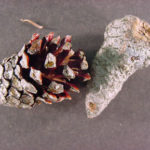jack pine (Pinus banksiana)
Family: Pinaceae
Categories |
Images |
|---|---|
| Form:
This tree is medium in size and reaches 70 to 80 ft. in height and 1 to 1 1/2 ft. dbh. It has an irregular crown and is a poor self pruner. |
|
| Needles: Arrangement: 2 per fascicle Length: 3/4- 1” long Shape: slightly flattened and twisted; widely forking; shiny green Other: concave on the inner surface [if 789 not_equals=””] Shape: [/if 100] |
|
| Bark:
The bark is grayish-brown in color and thin with narrow scaly ridges. |
|
| Cones:
The cones are serotinous, oblong, and light brown to silvery in color. |
|
| Distinguishing Characteristics:
This species has oblong serotinous cones. The needles are 3/4″ to 1″ in length and it has a grayish-brown bark. |
|
| Range:
This is a northern species. It occurs mainly around the Great Lakes area and the north eastern U.S. |
|
| Silvics:
This species is intolerant and occurs on sandy soils, dunes, on rock outcrops. It is often found in extensive pure stands. |
|
| Ecological and Cultural Importance:
This trees wood is used in pulpwood, fence posts and railroad ties. It is also a pioneer species. The endangered Kirtland’s warbler nests in large stands of young jack pine. The seeds are eaten by a variety of birds and rodents. |


